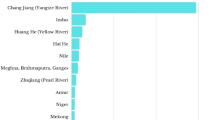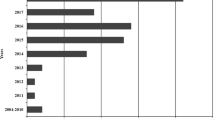Abstract
In this study, the grain-size and clay-mineral compositions of 73 surface sediment samples collected in a variety of environmental settings in the White Sea are presented to characterize recent sedimentation processes, reconstruct transport pathways, and identify potential source areas of the terrigenous components. Areas >100 m deep are invariably characterized by silty clay, whereas areas <100 m deep exhibit more heterogeneous grain-size compositions plausibly explained by coastal erosion and (re-)distribution mechanisms, particularly tidal currents. The dominance of sand in the estuarine areas of the Onega and Dvina rivers as well as toward the Gorlo Strait connecting the White Sea with the Barents Sea is attributed to increased current speeds. Illite and smectite are the dominant clay minerals in recent sediments of the southwestern and eastern White Sea sectors, respectively. Their distribution patterns largely depend on the geology of the source areas, and mirror surface circulation patterns, especially in Dvina Bay. Smectite is a key clay mineral in White Sea surface sediments, as it reveals the dominating influence of the Northern Dvina’s runoff on sedimentation and water circulation throughout the basin. In comparison to other Eurasian shelf seas, the White Sea is characterized by a greater diversity of clay-mineral assemblages, which range from illite- to smectite-dominated sectors containing variable amounts of chlorite and kaolinite.






Similar content being viewed by others
References
ACIA (2005) Arctic climate impact assessment scientific report 2005. Cambridge University, Cambridge
Aitchison J (1982) The statistical analysis of compositional data. J R Stat Soc Series B Stat Methodol 44(2):139–177
Aksyonov AA (ed) (1987) Arctic shelf of Eurasia in late quaternary (in Russian). Nauka, Moscow
Babkov A, Golikov A (1984) Hydrobiocomplexes of the White Sea (in Russian). Zoologichesky Institute, AN SSSR, Leningrad
Belderson RH, Johnson MA, Stride AH (1978) Bed-load partings and convergences at the entrance to the White Sea, U.S.S.R., and between Cape Cod and Georges Bank, U.S.A. Mar Geol 28:65–75
Berger V, Dahle S, Galaktionov K, Kosobokova X, Naumov A, Rat’kova R, Savinov V, Savinov T (2001) White Sea. Ecology and environment. Derzavets, St. Petersburg
Biscaye PE (1965) Mineralogy and sedimentation of recent deep-sea clays in the Atlantic Ocean and adjacent seas and oceans. Geol Soc Am Bull 76:803–832. doi:10.1130/0016-7606
Chamley H (1989) Clay sedimentology. Springer, Berlin
Darby DA, Naidu AS, Mowatt TC, Jones G (1989) Sediment composition and sedimentary processes in the Arctic Ocean. In: Herman Y (ed) The Arctic seas—climatology, oceanography, geology, and biology. Van Nostrand Reinhold, New York, pp 657–720
Davies D, Bouldin D (1979) A cluster separation measure. IEEE Trans Pattern Anal Machine Intell PAMI 1:224–227
Dolginow J, Kropatschjow S (1994) Geologie Russlands und angrenzender Staaten. Deutsche Bearbeitung von E. Klitzsch. E. Schweizerbart’sche Verlagsbuchhandlung, Stuttgart
Ehrmann W, Melles M, Kuhn G, Grobe H (1992) Significance of clay-mineral assemblages in the Antarctic Ocean. Mar Geol 107:249–273. doi:10.1016/j.margeo.2004.05.027
Elverhøi A, Pfirman SL, Solheim A, Larssen BB (1989) Glaciomarine sedimentation in epicontinental seas exemplified by the Northern Barents Sea. Mar Geol 85:225–250. doi:10.1016/0025-3227(89)90155-2
Filatov N, Pozdnyakov D, Johannessen O, Pettersson L, Bobylev L (2005) White Sea—Its marine environment and ecosystem dynamics influenced by global change. Springer, Berlin
Fütterer D, Galimov E (2003) Siberian river run-off into the Kara Sea: characterization, quantification, variability and environmental significance—an introduction. In: Stein R, Fahl K, Fütterer D (eds) Siberian river run-off into the Kara Sea: characterization, quantification, variability and environmental significance. Proceedings in Marine Science, vol 6. Elsevier, Amsterdam, pp 1–8
Ganopolski A, Rahmstorf S (2001) Rapid changes of glacial climate simulated in a coupled climate model. Nature 409:153–158. doi:10.1038/35051500
Gordeev V (2000) River input of water, sediment, major ions, nutrients, and trace metals from Russian territory to the Arctic Ocean. In: Lewis E, Jones EP, Lemke P, Prowse TD, Wadhams P (eds) The freshwater budget of the Arctic Ocean. Kluwer, Dordrecht, pp 297–322
Gordeev V, Martin J, Sidorov I, Sidorova M (1996) A reassessment of the Eurasian river input of water, sediment, major elements, and nutrients to the Arctic Ocean. Am J Sci 296:664–691
Gurevich VI (1995) Recent sedimentogenesis and environment of the Arctic shelf of western Eurasia. Norsk Polarinst Meddelelser 131:1–92
Harms IH, Karcher MJ, Dethleff D (2000) Modelling Siberian river runoff—implications for contaminant transport in the Arctic Ocean. J Mar Syst 27:95–115. doi:10.1016/S0924-7963(00)00062-2
IPCC (2007) Intergovernmental Panel on Climate Change report 2007. IPCC, Geneva
Kalinenko V (2001) Clay minerals in sediments of the Arctic seas. Lithol Mineral Resources 36(4):418–429
Kalinenko V, Rateev M, Kheirov M, Shevchenko A (1974) Clay minerals in sediments of the White Sea (in Russian). Lithol Mineral Resources 4:10–23
Krylov AA, Andreeva IA, Vogt C, Backman J, Krupskaya VV, Grikurov GE, Moran K, Shoji H (2008) A shift in heavy and clay mineral provenance indicates a middle Miocene onset of a perennial sea ice cover in the Arctic Ocean. Paleoceanography 23:1–10. doi:10.1029/2007PA001497
Leonov AV, Chicherina OV (2004) Nutrient transport into the White Sea with river runoff. Water Resour 31(2):152–173
Lisitzin AP (1995) The marginal filter of the ocean. Oceanology 34:671–682
Lisitzin AP (2002) Sea-ice and iceberg sedimentation in the ocean. Recent and past. Springer, Berlin
Lisitzin AP (2010) Marine ice-rafting as a new type of sedimentogenesis in the Arctic and novel approaches to studying sedimentary processes. Russ Geol Geophys 51:12–47
Migdisov A, Balashov Y, Sharkov K, Sherstennikov O, Ronov A (1994) Distribution of rare earth elements in main lithological types of sedimentary cover of the Russian Plate (in Russian). Geochemistry 6:789–803
Milanovsky E (1987) Geology of the USSR. Part 1 (in Russian). Moscow State University, Moscow
Nevesskiy EN, Medvedev VS, Kalinenko VV (1977) The White Sea: sedimentogenesis and history of development in Holocene (in Russian). Nauka, Moscow
Nürnberg D, Wollenburg I, Dethleff D, Eicken H, Kassens H, Letzig T, Reimnitz E, Thiede J (1994) Sediments in the arctic sea ice: implications for entrainment, transport and release. In: Thiede J, Vorren T, Spielhagen R (eds) Arctic Ocean marine geology. Mar Geol 119:185–214
Nürnberg D, Levitan M, Pavlidis J, Shelekova E (1995) Distribution of clay minerals in surface sediments from the eastern Barents and south-western Kara seas. Geol Rundsch 84:665–682
Pavlidis Y, Sherbakov F, Shevchenko A (1995) Clay minerals in bottom sediments of Cuba and the White Sea shelves: a comparison of geological and climatic controls. Oceanology 35(1):112–118
Pawlowsky-Glahn V, Egozcue JJ (2006) Compositional data and their analysis: an introduction. In: Buccianti A, Mateu-Figueras G, Pawlowsky-Glahn V (eds) Compositional data analysis in the geosciences: from theory to practice. Geol Soc Lond Spec Publ 264:1–10
Peterson B, Holmes R, McClelland J, Vörösmarty C, Lammer R, Shiklomanov A, Shikolomanov I, Rahmstorf S (2002) Increasing river discharge to the Arctic Ocean. Science 298:2171–2173. doi:10.1126/science.1077445
Petschick R, Kuhn G, Gingele F (1996) Clay mineral distribution in surface sediments of the South Atlantic: sources, transport, and relation to oceanography. Mar Geol 130:203–229. doi:10.1016/0025-3227(95)00148-4
Pokrovsky OS, Viers J, Shirokova LS, Shevchenko VP, Filipov AS, Dupré B (2010) Dissolved, suspended, and colloidal fluxes of organic carbon, major and trace elements in the Severnaya Dvina River and its tributary. Chem Geol 273:136–149
Press F, Siever R (1995) Allgemeine geologie. Spektrum, Heidelberg
Rachold V, Grigoriev M, Are F, Solomon S, Reimnitz E, Kassens H, Antonow M (2000) Coastal erosion vs riverine sediment discharge in the Arctic Shelf seas. Int J Earth Sci 89:450–460. doi:10.1007/s005310000113
Rachold V, Are FE, Atkinson DE, Cherkashov G, Solomon SM (2005) Arctic Coastal Dynamics (ACD): an introduction. In: Rachold V et al. (eds) Arctic Coastal Dynamics. Geo-Mar Lett SI 25(2/3):63–68. doi:10.1007/s00367-004-0187-9
Rateev MA, Sadchikova TA, Shabrova VP (2008) Clay minerals in recent sediments of the world ocean and their relation to types of lithogenesis. Lithol Mineral Resources 43(2):125–135. doi:10.1134/S002449020802003X
Schoster F, Behrends M, Müller C, Stein R, Wahsner M (2000) Modern river discharge and pathways of supplied material in the Eurasian Arctic Ocean: evidence from mineral assemblages and major and minor element distribution. Int J Earth Sci 89:486–495. doi:10.1007/s005310000120
Schumann W (1997) Der neue BLV Steine- und Mineralienführer. BLV Verlagsgesellschaft, München
Seibold E (1974) Der Meeresboden. Ergebnisse und Probleme der Meeresgeologie. Springer, Berlin
Semenov EV, Luneva MV (1999) The joint effect of tide, stratification, and vertical turbulence on formation of hydrophysical fields of the White Sea (in Russian). Physics Atmosphere Ocean 35:660–678
Shapiro GI, Latché L, Pantiulin AN (2003) Mixing processes in the Gorlo Strait of the White Sea. Oceanology 43:26–31
Shepard FP (1954) Nomenclature based on sand-silt-clay ratios. J Sediment Petrol 24:151–158
Shevchenko V, Dolotov Y, Filatov N, Alexeeva T, Filippov A, Nöthig E-M, Novigatsky A, Pautova L, Platanov A, Politova N, Rat’kova T, Stein R (2005) Biogeochemistry of the Kem River estuary, White Sea (Russia). Hydrol Earth Syst Sci 9:57–66
Shevchenko VP, Pokrovsky OS, Filippov AS, Lisitzin AP, Bobrov VA, Bogunov AY, Zavernina NN, Zolotykh EO, Isaeva AB, Kokryatskaya NM, Korobov VB, Kravchishina MD, Novigatsky AN, Politova NV (2010) On the elemental composition of the Severnaya Dvina River (White Sea Region). Dokl Earth Sci 430(2):228–234
Stein R (2008) Arctic Ocean sediments: processes, proxies, and palaeoenvironment. Developments in marine geology, vol 2. Elsevier, Amsterdam
Stein R, Macdonald R (eds) (2004) The organic carbon cycle in the Arctic Ocean. Springer, Berlin
Stein R, Grobe H, Wahsner M (1994) Organic carbon, carbonate, and clay-mineral distributions in eastern central arctic ocean surface sediments. In: Thiede J, Vorren T, Spielhagen R (eds) Arctic Ocean marine geology. Mar Geol 119:269–285. doi:10.1016/0025-3227(94)90185-6
Tucker M (1996) Methoden der Sedimentologie. Ferdinand Enke, Stuttgart
Viscosi-Shirley C, Mammone K, Pisias N, Dymond J (2003) Clay mineralogy and multi-element chemistry of surface sediments on the Siberian-Arctic shelf: implications for sediment provenance and grain size sorting. Cont Shelf Res 23:1175–1200. doi:10.1002/jqs.1152
Vogt C (1997) Regional and temporal variations of mineral assemblages in Arctic Ocean sediments as climatic indicator during glacial/interglacial changes (in German). Alfred-Wegener-Institut, Bremerhaven, Ber Polarforsch 251(30/42):1–309
Vogt C, Knies J (2008) Sediment dynamics in the Eurasian Arctic Ocean during the last deglaciation—the clay mineral group smectite perspective. Mar Geol 250:211–222. doi:10.1016/j.margeo.2008.01.006
Vogt C, Knies J (2009) Sediment pathways in the western Barents Sea inferred from clay mineral assemblages in surface sediments. Norwegian J Geol 89:41–55
Wahsner M, Müller C, Stein R, Ivanov G, Levitan M, Shelekhova E, Tarasov G (1999) Clay-mineral distribution in surface sediments of the Eurasian Arctic Ocean and continental margin as indicator for source areas and transport pathways—a synthesis. Boreas 28:215–233. doi:10.1080/030094899421272
Acknowledgements
We would like to thank the crews and participants of the R/V Professor Shtokman and the R/V Ekolog cruises to the White Sea in August of 2003 and 2004. The authors thank the leader of the “White Sea System” project Prof. Alexander Petrovich Lisitzin for support in our studies. Rita Fröhlking and Susanne Wiebe from the Alfred-Wegener Institute (AWI), Bremerhaven, are acknowledged for technical support. Jens Matthiessen (AWI) is thanked for numerous discussions. We acknowledge the reviewers and the journal editors for constructive criticism and useful comments.
Author information
Authors and Affiliations
Corresponding author
Rights and permissions
About this article
Cite this article
Saukel, C., Stein, R., Vogt, C. et al. Clay-mineral and grain-size distributions in surface sediments of the White Sea (Arctic Ocean): indicators of sediment sources and transport processes. Geo-Mar Lett 30, 605–616 (2010). https://doi.org/10.1007/s00367-010-0210-2
Received:
Accepted:
Published:
Issue Date:
DOI: https://doi.org/10.1007/s00367-010-0210-2




